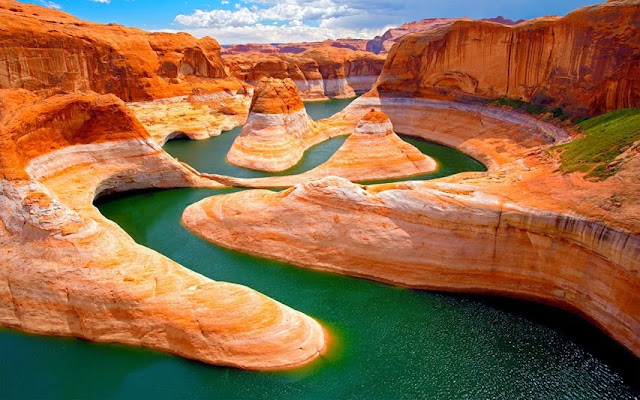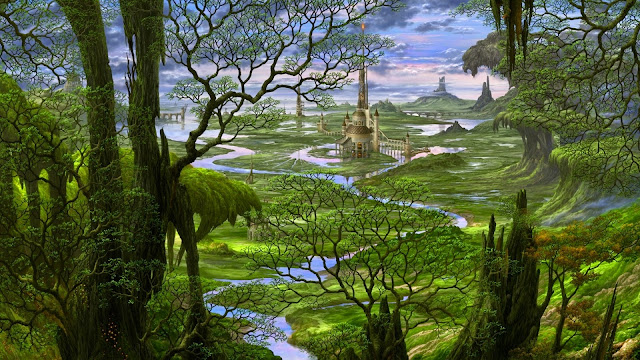Grand Canyon
The Grand Canyon (Hopi: Ongtupqa; Yavapai: Wi:kaʼi:la, Spanish: Gran Cañón), is a steep-sided canyon carved by the Colorado River in the state of Arizona in the United States. It is contained within and managed by Grand Canyon National Park, the Hualapai Tribal Nation, the Havasupai Tribe and the Navajo Nation. President Theodore Roosevelt was a major proponent of preservation of the Grand Canyon area, and visited it on numerous occasions to hunt and enjoy the scenery.
The Grand Canyon is 277 miles (446 km) long, up to 18 miles (29 km) wide and attains a depth of over a mile (6,000 feet or 1,800 meters). Nearly two billion years of Earth's geological history have been exposed as the Colorado River and its tributaries cut their channels through layer after layer of rock while the Colorado Plateau was uplifted. While the specific geologic processes and timing that formed the Grand Canyon are the subject of debate by geologists, recent evidence suggests that the Colorado River established its course through the canyon at least 17 million years ago. Since that time, the Colorado River continued to erode and form the canyon to its present-day configuration.
For thousands of years, the area has been continuously inhabited by Native Americans who built settlements within the canyon and its many caves. The Pueblo people considered the Grand Canyon ("Ongtupqa" in the Hopi language) a holy site, and made pilgrimages to it. The first European known to have viewed the Grand Canyon was García López de Cárdenas from Spain, who arrived in 1540.
The Grand Canyon is 277 miles (446 km) long, up to 18 miles (29 km) wide and attains a depth of over a mile (6,000 feet or 1,800 meters). Nearly two billion years of Earth's geological history have been exposed as the Colorado River and its tributaries cut their channels through layer after layer of rock while the Colorado Plateau was uplifted. While the specific geologic processes and timing that formed the Grand Canyon are the subject of debate by geologists, recent evidence suggests that the Colorado River established its course through the canyon at least 17 million years ago. Since that time, the Colorado River continued to erode and form the canyon to its present-day configuration.
For thousands of years, the area has been continuously inhabited by Native Americans who built settlements within the canyon and its many caves. The Pueblo people considered the Grand Canyon ("Ongtupqa" in the Hopi language) a holy site, and made pilgrimages to it. The first European known to have viewed the Grand Canyon was García López de Cárdenas from Spain, who arrived in 1540.
Preikestolen
Preikestolen or Prekestolen, also known by the English translations of Preacher's Pulpit or Pulpit Rock, is a famous tourist attraction in Forsand, Ryfylke, Norway. It consists of a steep cliff which rises 604 metres (1982 feet) above Lysefjorden, opposite the Kjerag plateau, with an almost flat top of approximately 25 by 25 metres (82 by 82 feet).
Tourism at the site has been increasing in recent years, with between 150,000 and 200,000 visitors in 2012 making it one of the most visited natural tourist attractions in Norway. Due to its increased popularity, there is currently a project under way to improve the path to the site, which is only accessible via a 3.8 km (2.4 mi.) hike.
Tourism at the site has been increasing in recent years, with between 150,000 and 200,000 visitors in 2012 making it one of the most visited natural tourist attractions in Norway. Due to its increased popularity, there is currently a project under way to improve the path to the site, which is only accessible via a 3.8 km (2.4 mi.) hike.
- Apostle Islands National Lakeshore
- The Apostle Islands National Lakeshore is a U.S. national lakeshore consisting of 21 islands (Apostle Islands) and shoreline encompassing 69,372 acres (28,074 ha) on the northern tip of Wisconsin on the shore of Lake Superior. It is known for its collection of historic lighthouses, sandstone sea caves, a few old-growth remnant forests, and natural animal habitats.
Introduction
The Apostle Islands National Lakeshore is located off Wisconsin’s peninsula in Lake Superior, the “largest, cleanest, and coldest of the Great Lakes.” The lakeshore comprises beaches, cliffs, water, and 21 islands.Madeline Island is the only one of the Apostle Islands not included in the national lakeshore, although a portion of the island is protected as Big Bay State Park. The island's accessibility by ferry or ice road, along with the shops, restaurants and other commercial establishments of the island town of La Pointe, make it popular with visitors to the national lakeshore.Beginning in the west, going north around the outer islands, then west, then east, ending with the southernmost island, the islands are:History
The Apostle Islands are a result of the glaciers that once covered North America. “Geologically they are originally part of the main land at the edge of the great rift or fault which formed the depression to which the waters of Lake Superior collected.” When the glaciers melted, waves from the waters of Lake Superior caused erosion that formed the islands. The islands are composed of mostly red sandstone because of the glacial shift.
It is widely assumed that Indians were the first to inhabit the island. “There is some evidence that they were seen and possibly visited sometime in the fourteenth century by Indians who were making their way to Isle Royale near the north shore of the land in search of copper.” Not long after, the islands were visited by Étienne Brûlé, a French explorer who, like many French Canadians, was trying to discover a new way to the East Indies. "Historians believe that the Jesuits named the islands the Apostle Islands according to their practice of giving holy names to new places." It is said that fur traders were the first explorers to settle in the area, building a village from the money they brought in.
United States Senator Gaylord Nelson sponsored the federal legislation that established the Apostle Islands National Lakeshore. Public Law 91-424 was signed by the President on September 26, 1970. It included 20 islands, a 12-mile (19 km) strip of the mainland, and approximately 1/4 mile of Lake Superior jurisdiction adjacent to each land unit.
Public Law 99-497 in 1986 added Long Island to the National Lakeshore and transferred ownership of all the light stations from the U.S. Coast Guard to the National Park Service.
After the National Park Service completed a wilderness study in 2004, and received overwhelming support from the public, Congress designated 80 percent of the land area of the national lakeshore as the Gaylord Nelson Wilderness on December 8, 2004. (Public Law 108-447, Division E, Section 140)
The National Park Travelers Club held its 2012 convention at the Apostle Islands.
Fly Geyser
Fly Geyser, also known as Fly Ranch Geyser or the Green Geyser is a man-made small geothermal geyserlocated in Washoe County, Nevada approximately 20 miles (32 km) north of Gerlach. Fly Geyser is located near the edge of Fly Reservoir and is only about 5 feet (1.5 m) high, but 12 feet (3.7 m) wide, counting the mound on which it sits.


.jpg)

.jpg)
















